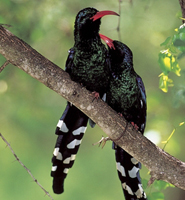Such behaviour in response to the threat of potential conflict suggests that birds may be capable of anticipation and future planning, a trait that was until recently considered the preserve of humans and other primates.
Dr Andy Radford, BBSRC Fellow in the University’s School of Biological Sciences, studied a population of green woodhoopoes (Phoeniculus purpureus), common forest-dwelling birds in southern Africa. Green woodhoopoes live in groups of up to twelve individuals, which include a dominant breeding pair and non-breeding, subordinate ‘helpers’ that assist in the raising of the dominants’ offspring. The birds frequently preen each other to promote social cohesion within the group.
The new research, published today in Biology Letters, found that dominant group members increase their preening of subordinates when moving into border areas where clashes with other groups are likely.
Dominants effectively form social contracts with subordinates, providing preening in exchange for participation in any intergroup conflicts that subsequently arise. “It’s a case of scratching your back if you cover mine”, Dr Radford said.
When in border zones, individuals did not preen themselves more than at other times, but focused their preening on each other. “Self-directed behaviour would indicate stress, whereas the increased preening of subordinates by their superiors is likely to be a deliberate social behaviour when the threat of conflict is higher,” Dr Radford explained.
It has long been suggested that conflicts between groups should influence behaviour within groups. But despite the prevalence of inter-group rivalry in many social species, almost no empirical studies have investigated this potential link in non-human animals.
These results emphasise that our understanding of co-operation, group dynamics and the evolution of sociality can be enhanced by investigating how interactions within a group are affected by interactions between groups.
